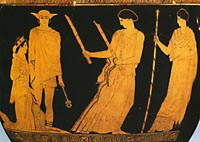

The Thesmophoria was the most popular of the festivals in honour of Demeter and her daughter Persephone. Only women took part. Its nucleus was the distinction of the sexes and the formation of a union of women. This served to emphasize women's role in the fertility both of the community and of arable land. At Athens the Thesmophoria lasted three days (from the eleventh of Pyanepsion to the thirteenth) and followed a special ritual. |
 |
The sacrifice of a pig was the festival's hallmark. It was explained by the myth of Persephone's abduction. In this myth, the swine of the pigman Eubulis had vanished into the bowels of the earth along with Persephone. Excavations at shrines of the Thesmophoria have brought to light similarly symbolic objects: offerings in the shape of a pig, and clay models showing either a female worshipper, or even Demeter herself, carrying a pig. A shrine of this kind was normally outside a city or on the slope of an acropolis. In Athens in particular, the site of the Thesmophorium has been identified near the Pnyx hill.
During the festival, women would gather at the shrine of Demeter, thus getting the chance to spend a few days well away from the house. They were allowed to bring their children with them, providing the latter were still of suckling age. Their spouses not only were obliged to give their consent that the women should attend the festival, but had to cover their estimated expenses. Virgins were not permitted to take part in the Thesmophoria. Whether hetairae and female slaves were, is a moot point.
The exclusion of men from the festival gave it the atmosphere of a mystery, and was duly noted by Aristophanes in his comedy Thesmophoriazusae.
 |
 |
|
| |
|||
| |||